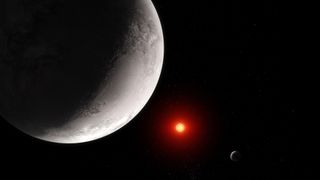New data from NASA's James Webb Space Telescope (JWST) shows that the atmosphere of a rocky exoplanet in the TRAPPIST-1 system is either non-existent or incredibly thin, making it unfavorable for hosting life as we know it.
Astronomers using JWST were able to calculate the amount of heat energy coming from TRAPPIST-1 c, revealing that the dayside temperature of the rocky world is about 225 degrees Fahrenheit (107 degrees Celsius) — the coolest rocky exoplanet ever characterized. At this temperature, the exoplanet's atmosphere is likely extremely thin, if it exists at all, according to a statement from NASA.
Located 40 light-years from Earth, TRAPPIST-1 c is one of seven rocky planets orbiting an ultracool red dwarf star, the most common type of star found in our Milky Way galaxy. Therefore, studying this exoplanet system helps astronomers better understand if these types of stars can host worlds able to support life as we know it here on Earth.
Related: James Webb Space Telescope — A complete guide
"We want to know if rocky planets have atmospheres or not," Sebastian Zieba, first author of a new study announcing the results and a graduate student at the Max Planck Institute for Astronomy in Germany, said in the NASA statement.
"In the past, we could only really study planets with thick, hydrogen-rich atmospheres," Zieba said. "With Webb, we can finally start to search for atmospheres dominated by oxygen, nitrogen and carbon dioxide."
While the worlds orbiting TRAPPIST-1 are similar in size and mass to the inner, rocky planets in our own solar system, the composition of the exoplanets' atmospheres remains unclear. That's where JWST comes in: The telescope's powerful Mid-Infrared Instrument (MIRI) helps astronomers characterize rocky exoplanets, such as TRAPPIST-1 c.
Initially, astronomers thought TRAPPIST-1 c might have a thick carbon dioxide atmosphere like Venus, given it is about the same size and receives a similar amount of radiation from its host star as Venus gets from the sun. However, red dwarf stars like TRAPPIST-1 emit bright X-ray and ultraviolet radiation that can easily strip away a planet's atmosphere. It's also possible that, at the time the exoplanet formed, there was not enough water, carbon dioxide and other volatiles available to make an atmosphere, according to the statement.
Using MIRI, the research team compared the brightness of light emitted by TRAPPIST-1 c as it moved behind its host star to when the planet was beside the star. By doing this, the team was able to calculate the amount of mid-infrared light emitted by the planet, which is directly related to its temperature and, in turn, its atmospheric composition. The emissions observed from TRAPPIST-1 c suggest a lack of carbon dioxide gas that would have otherwise absorbed the light coming from the planet.
"Our results are consistent with the planet being a bare rock with no atmosphere, or the planet having a really thin CO2 atmosphere (thinner than on Earth or even Mars) with no clouds," Zieba said in the statement.
Given that TRAPPIST-1 c lacks a thick atmosphere, the astronomers suggest that it may have formed with relatively little water, or any of the other components necessary to make the planet habitable.
"It is extraordinary that we can measure this," study co-author Laura Kreidberg, also of the Max Planck Institute for Astronomy, said in the statement. "There have been questions for decades now about whether rocky planets can keep atmospheres. Webb's ability really brings us into a regime where we can start to compare exoplanet systems to our solar system in a way that we never have before."
The new findings were published June 19 in the journal Nature.

